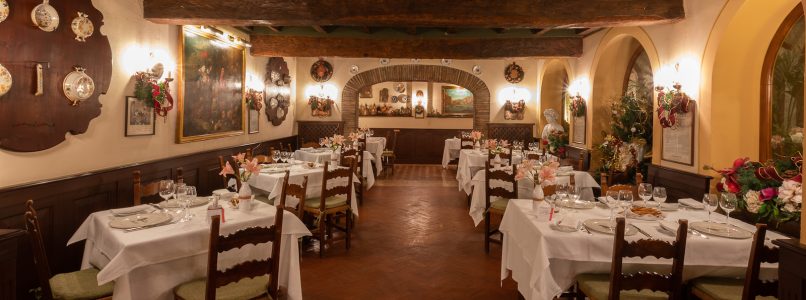A poor dish that has become an iconic recipe by chef Enrico Crippa. In its version, the best hazelnuts and many, many eggs, to be incorporated with a special technique. The result? Elegant, very soft and without a crumb
The hazelnut cake is one of those recipes so rooted in tradition that it has a Wikipedia page and one in the recipe books of all Piedmontese grandmothers. It was born as a peasant dish, a way to prepare a flourless Christmas cake, expensive at the time, using instead the leftovers of summer hazelnuts that were collected in the woods. Now it is a popular dessert, which is prepared at home as in a pastry shop, and where everyone adds their own secret touch: with or without flour? With or without yeast? Surely with hazelnuts, the famous Tonda Gentile Trilobata PGI, queen of the Langhe, considered by many to be the best in the world, so much so that it has made the fortune of the most important companies in Alba.
Making hazelnuts like wine: the Ceretto method
Right here in the most suitable area is born the Alba Hazelnut Cake signed by chef Enrico Crippa, Piedmontese by adoption, thanks to Ceretto family. The Ceretto are a well-known surname, for generations they have invested heavily in the territory, starting with wine and arriving at the collaboration with artists and designers who have brought their works to the area and made Alba an international crossroads. Part of this mission for beauty and goodness is Relanghe, the family confectionery company and, of course, the spearhead: the Piazza Duomo restaurant in Alba, which, thanks to the partnership established with chef Enrico Crippa, has obtained the 3 Michelin stars.
The Ceretto have been applying to hazelnut cultivation Tonda Gentile Trilobata PGI the methods already used for their excellent vineyards. The selection is rigorous and many of the steps remain handmade. Finally, roasting is the most important moment, since it can ruin all the work done: the temperature is precisely calibrated and the hazelnuts are put in constant motion, making sure that none of them break. The result of the work is a delicate but unmistakable hazelnut, with an intense aroma, which goes rancid in much longer times than the others.
The hazelnut cake, from a non-Piedmontese
Enrico Crippa, born in Brianza, he was trained first by Marchesi and then in Japan, he met the Ceretto family in 2005 who were looking for a strong chef who could lead them to their goal and embrace their philosophy and devotion to these lands. Today Crippa's award-winning cuisine is based on the control of the supply chain and the study of the crops, which he practices in his garden and greenhouse, now legendary, and which are the basis of the scrupulous research of each raw material. "The challenge was to interpret one of the most famous and traditional desserts, the one that every Piedmontese woman creates and handed down from generation to generation", says Crippa who has chosen to create own version of the hazelnut cake as a gift. "It was love at first sight and my recipe is meant to be a tribute to the hazelnut of the Langhe and at the same time a symbol of the city of Alba".
The super soft recipe
Remaining absolutely faithful to tradition, the recipe of Alba Hazelnut Cake designed by Crippa for Relanghe changes some typical characteristics of homemade hazelnut cake such as excessive friability and general dryness, which makes you need at least a glass of milk to be able to swallow it. He succeeded in making the dough absorb many more eggs compared to the common version (pay attention to the crucial passage explained in the text). The result is a soft and tasty dessert, totally devoid of flour and able to fully express the flavor of the delicate Piedmontese hazelnut. So elegant to be served as a dessert with a glass of Muscat or a coffee. Theirs is on sale on the online shop and in the best wine shops and shops, together with the basic ingredients by Relanghe. But here is the exclusive recipe to do it again at home.
Ingredients for two 24cm molds
100 g Piedmont hazelnut paste I.G.P.
200 g Piedmont hazelnut flour I.G.P
200 g grains of Piedmont hazelnuts I.G.P.
300 g butter
180 g sugar
14 eggs
1 sachet of baking powder
Method
Preheat the oven to 180 degrees.
Separate the yolks from the whites.
Whip the soft butter with 140 g sugar and the hazelnut paste.
This is the crucial step: gently add the egg yolks, one at a time, until they are completely absorbed.
Once done, add the sifted hazelnut flour, when this is incorporated add the chopped hazelnuts and the sachet of leavening powder.
Start whipping the egg whites, add the remaining sugar, finish whipping until stiff.
Gently mix the egg whites with the rest of the dough, taking care to leave the mixture well whipped.
Arrange everything in greased and floured cake pans. Place in the oven and lower the oven temperature to 170 °, let it cook for 40 minutes. Allow to cool before serving.
Text Margo Schachter, Jacopo Giavara

